FAQs
To view the FAQs from our course team, click the arrows below to expand each category.
Is there a WhatsApp group for practising IELTS speaking?
There are a number of WhatsApp groups and Skype groups if you look through the posts on the Discussion Forum. Search 'by most activity'.
Whenever someone asks me a question, I spend a lot of time trying to think about the answer and I can't speak fluently. What can I do to improve my fluency?
It's very important to try and increase your vocabulary so that you are more familiar with a range of topics. If you are able to access the correct words, it makes it easier to answer questions.
It's also a good idea to learn 'discourse markers' and phrases that you can use when you are trying to think of what to say. For example:
- That's an interesting question.
- That's a difficult question, but I will try and answer it.
- Let me see... / Let me think about that...
- Unfortunately, I have never experienced that, but I will try and answer your question.
How can I get my microphone to work?
Make sure you are using the latest version of common browsers and be sure to give permission to IELTSx to use your microphone (follow the picture below). If your microphone worked in the past, you might need to clear your browsing history and try again.
Always allow on this site:

Allow IELTSx to use your microphone:
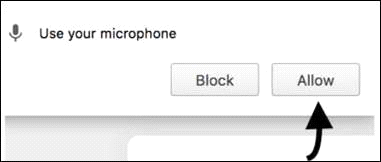
Where are the audio files?
Are you having trouble with the audio files in the Listening module? Some listeners have had trouble downloading them. We've checked the audio files personally and they are all there. Here are some things you can try if you having problems with locating the audio files:
The issue may be related to your device or your internet speed. The audio files are the last to load on the page. Try accessing the course in another location where the internet speed is faster/more reliable. You should be able to see this icon:

If you are using the app and having problems downloading the audio, make sure that you have updated the app. If you are still having problems, this may be related to your phone model or operating system. If this is the case, try accessing the course via Google Chrome instead.
This course is best viewed with the lastest version of common browsers such as Google Chrome. The edX platform is routinely tested and verified on the current version and the previous version of each of these browsers. Make sure you are using the latest version.
Also please note that the first audio in Listening Unit 1 only appears half way through the unit, here: Listening > Unit 1: Unit Overview - Listening for the Main Idea. The exercises in the first half of this unit do not require audio.
How can I improve my listening skills?
To improve your listening skills, first, we would advise you to complete the Listening module for this course. For section 3, you should particularly focus on Unit 5. In addition, we always advise students to listen widely and listen often. In other words, depending on your interests, you might prefer to listen to songs, radio podcasts, news bulletins, or lectures. You can also choose to listen to audio material or watch videos, they are all useful!
Here are some online listening resources that you might want to try:
- ABC Radio National, BBC and Voice of America podcasts
- TED talks
- Behind the News Randall's ESL Cyber Listening Lab
- British Council
- Learn English
When you listen to talks or radio programs, see if you can download a transcript. You can try listening first without the transcript, and then listening with the transcript.
There are plenty of materials available on the internet, but make sure to always visit the official IELTS sites as these materials will be developed specially for the IELTS test. Below are links to two sites which have a lot of practice material and valuable information.
How many correct answers do I need to reach a band score of 7.0 in the IELTS Listening test?
Please look at the following site and it will give you information about how scores are calculated. Every test is slightly different, so a band 7 will vary. In general, a score of around 32-34 will give you a band 7. https://www.ielts.org/ielts-for-organisations/ielts-scoring-in-detail
Should I use British or American spelling when I write my answers in the Listening test?
In the IELTS test, both British and American spelling are accepted. But please remember to be consistent and only use one version. Do not mix them!
For example:
- The rug is a meter long and it's really colourful. (Mix of British and American spelling)
- The rug is a meter long and it's really colorful. (American spelling)
- The rug is a metre long and it's really colourful. (British spelling)
I am having problems downloading the audio. How can I fix this?
If you are using the app and having problems downloading the audio, make sure that you have updated the app. If you are still having problems, this may be related to your phone model or operating system. If this is the case, try accessing the course via Google Chrome instead.
This course is best viewed with the latest version of common browsers such as Google Chrome. The edX platform is routinely tested and verified on the current version and the previous version of each of these browsers. Make sure you are using the latest version.
How can I improve my reading skills?
Have you done the reading section of the IELTSx course? There are lots of exercises where you need to read and answer questions. This is very good practice at reading comprehension.
There are lots of reading materials available on the internet. It is also important to try and build your vocabulary. Have you studied the Academic Word Lists given to you on the Home page?
If you go through all the exercises, you will build up your vocabulary in an appropriate way, which will help your reading skills.
In addition to doing the IELTSx course, try to read as much as possible. Read books or articles in English to improve your reading skills. For general reading practice, you can try magazines such as Time, Newsweek, The Economist, National Geographic, or Scientific American. You could also borrow a graded reader from the library and read a novel in English. Read every day, whenever you can - on the bus, before bed - and make this a regular habit.
For additional reading test practice, once you have completed the course, try and look at official IELTS websites like the following ones listed as they will give you tests that are very similar to the official IELTS test:
In the Reading test, should we read the questions first and then the passage or vice versa?
The Reading test is in three sections. Each of the three reading passages has a series of questions attached to it. There are 40 questions in all, and you should try and attempt all questions. Many people like to start with Section 1 first, but you can start with Section 1, 2 or 3.
Many people recommend reading the questions first. This is useful because it means that you read the text with purpose and don't waste time. On the other hand, some people recommend reading the text quickly first, just to get a general idea of what it is about, before attempting the questions. Everyone is unique, so we recommend trying out both of these strategies to see what works for you.
Another thing you need to do is to manage your time effectively. Remember, you have 40 questions to answer in one hour, so don't spend too long on any one question. If you get stuck on a particular question, leave it and go on. You can come back to it at the end, if you have time.
The test practice materials provided in this course will help you to pracice all of these strategies.
Are the questions asked in the reading section given in the same sequence as they are given in the text?
The answers to these reading questions are not in text order:
- Matching headings
- Locating information
- Matching names with statements or information
The answers to these task types usually follow the same order as the reading passage:
- Filling in the gaps, e.g. sentence or summary completion
- True, False, Not Given or Yes, No, Not Given
- Multiple choice
- Matching sentence endings
- Short answer questions
Here is a link where you can read more about the academic Reading test format: https://www.ielts.org/about-the-test/test-format-in-detail#pagecontent_0_tab5
How can I choose between 'False' and 'Not Given' answers?
True/False/Not Given and Yes/No/Not Given tasks are challenging for many test-takers. Unit 7 in the Reading module of the IELTSx course focuses on these tasks exclusively.
Just to recap, the questions in the True/False/Not Given task ask you to say whether the reading passage:
- provides evidence to support an idea (True)
- says the opposite of an idea (False)
- does not give enough information for you to check whether an idea is true or false (Not Given)
Something to bear in mind is that the questions are in the same order as the information in the passage. There will be some key words in the questions that will help you to find the relevant part of the passage. However, the statements may not use exactly the same words as in the reading passage. In other words, they may be paraphrased.
If an answer is 'Not Given', it means that there is no information in the text to support whether the claim is true or false. An easy example is often given at the UQ IELTS Masterclass.
There are 3 bananas for sale:
Banana A = $1
Banana B = $2 (good quality)
Banana A = $3
If the statement is: Banana C is the best quality banana, the answer must be 'Not Given'. The only banana that mentions quality is banana B. We do not know what quality banana C is, we just have information telling us the price.
We usually guess the meaning as we use our prior knowledge and this often causes issues. Only answer 'Not Given' if there is nothing in the text to decide if a view is true or false.
Can I write Y, N, and NG instead of Yes, No, Not Given? Can I also write T, F and NG for True, False, Not Given?
It is very important to fill in the answer sheet carefully. Yes, you can write a letter instead of the whole word.
How can I get feedback on my writing?
The IELTSx course uses Peer Assessment of Writing to allow you to give and to receive feedback. The purpose of peer assessment is to:
- help you learn about the IELTS Writing criteria because it is used to evaluate your own writing;
- help you understand how to evaluate examples and how you should check your own writing in an exam;
- help you identify your own writing strengths and areas for development;
- motivate you to write better because you know other students will read your writing.
The most important aim of peer assessment is not to score your writing - it is to develop your own writing using feedback from your peers. If you complete the peer assessment in the proper way, you should be able to self-assess your own writing more accurately.
This cannot happen without you doing your best to evaluate and give feedback about the writing of other IELTSx students.
For you to get useful feedback, you need to give useful feedback, so it is important to remember the following peer assessment etiquette; always remember:
- complete all assessment steps in the activity thoroughly - do not 'click through' quickly;
- read all instructions and criteria carefully;
- when writing, use your own words - do not cut and paste or copy from the internet - you will not learn how to write in an IELTS test by doing this;
- when assessing, use the criteria for that writing task only - do not assess using different features that you believe are important. For example: evidence of research and citations are not required; your agreement with opinions is not required.
Task 1: Please explain the structure for writing task 1
Have you looked at the IELTSx Writing unit focusing on Task 1?
For Task 1 you simply have to include 3 things:
- The introduction - paraphrase the question - what, where and when
- Present a clear overview describing the main trends in the diagram
- Present the key features and use supporting data for your description
This is the structure that should be presented for Task 1.
Task 1: Is it important to make comparisons in Writing Task 1 even though the question doesn't mention it and simple tells us to describe?
It is very important to make comparisons in your Task 1 response. You are in fact asked to do that. Read the question carefully.
Summarise the information by selecting and reporting the main features, and make comparisons where relevant.
There are various ways that you can do this and it depends on what you have to describe. You can write about data in terms of:
- things that are similar, the same or equal
- things that change over time
- things that differ in proportion, number or amount
- the most / the highest / the least / the lowest etc
- something that is more / less than the other(s)
Task 2: Is Task 2 the same in the Academic and General Training versions of IELTS?
Task 2 is basically the same for Academic and General Training Writing. You are asked for your opinion on something and have to present ideas to support your position.
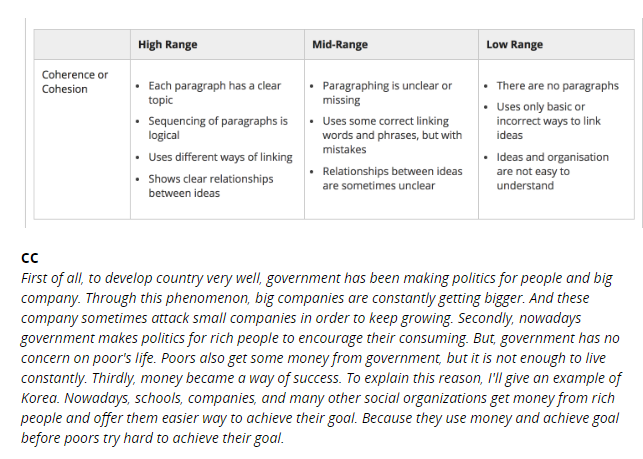
IELTS Writing Task 2 Sample Paragraph 1: Cohesion and Coherence
This extract was chosen because it illustrates some common issues related to cohesion and coherence that occur in student writing. Coherence and cohesion are closely-related terms. Basically, coherence refers to how easy the text is to understand, in terms of the sequence of ideas and how they are connected. Cohesion relates to the grammar and vocabulary that the writer uses to link the sentences.
Let’s start with paragraph unity. For the essay to be awarded a high range in coherence and cohesion, each paragraph should have a clear topic. In other words, there should be one central idea with some supporting details. The topic sentence should make the topic of the paragraph clear. Let’s say that this is a paragraph from the body of the essay. This paragraph lacks a suitable topic sentence. It launches into the first supporting detail without giving the overall topic first. A suitable topic sentence might look something like this: There are several reasons why the gap between the rich and the poor is getting wider.
Another aspect to consider in this extract is the use of linking words and phrases. You can see here that the writer has used some simple linking devices accurately – First of all, Secondly, and Thirdly. However, there are errors in their usage, such as But, in the fourth sentence. A linking word like However, would be more appropriate in this instance.
Finally, is the relationship between the ideas clear? The idea stated in the first sentence (governments catering to big business) is developed in the second sentence (large companies keep growing). The writer makes this connection clear with the linking phrase Through this phenomenon. In this case, the writer was successful in making the connection. On the other hand, the writer’s third point (money has come to mean success) is not successfully developed in the final three sentences of the paragraph. It isn’t clear how the supporting details about the situation in Korea support this point.
To sum up, this paragraph has some strengths and weaknesses in terms of cohesion and coherence. For this reason, we would award it a mid-range score.
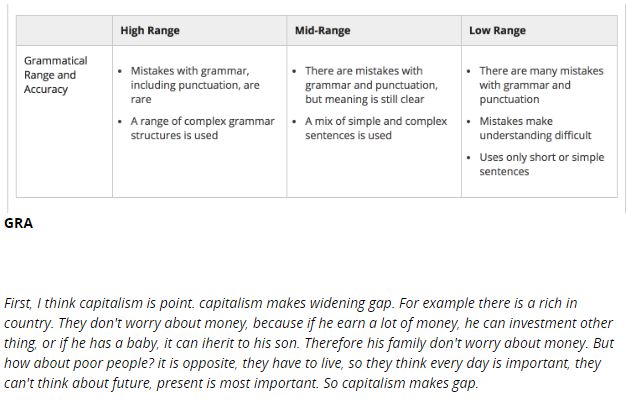
IELTS Writing Task 2 Sample Paragraph 2: Grammar
This extract illustrates some aspects of grammatical range and accuracy that can be problematic for students. For example, in this paragraph, there are recurring errors relating to the use of articles. For example, in the second sentence, the article is missing before widening gap. It should be a widening gap. Overall, the mistakes are frequent – there are no error-free sentences. The writer has attempted to write some longer sentences (e.g. sentence 3), but these are not accurate. Punctuation and spelling mistakes are evident, such as the lack of capitalisation at the beginning of this sentence: it is opposite (It is the opposite), the spelling mistake in iherit (inherit) and the comma splices in this sentence: …they think every day is important, they can’t think about future, present is most important. (…they think every day is important. They can’t think about the future, because the present is most important).
To sum up, the frequency of grammatical errors in this paragraph give it a low range score.

IELTS Writing Task 2 Sample Paragraph 3: Vocabulary
This extract displays some very good examples of lexis (vocabulary) related to health, employment, and politics. The writer also shows a good awareness of collocations (words which go together) such as basic amenities, treatment and medication, root cause, corrupt politicians. However, the second paragraph displays some limitations in vocabulary. Notice how employment and its related forms are used repetitively in the second paragraph. The writer could have used some other words, such as jobs, or work and other forms of the word employment. For example, we usually talk about the unemployment rate, not the rate of employment. There are some errors made with inappropriate word choice and collocation, such as to fulfill in their lives and doing scams. Based on all of the above, this essay would be awarded a mid-range grade for lexical resource.
Does this course prepare students for the Academic version of the IELTS test or the General Training version?
Although this course is designed to prepare students for the Academic version of the IELTS test, it will also help you prepare for the General Training test. The skills and strategies that you learn in this course can be used in a General Training test.
The Speaking and Listening modules are exactly the same.
The General Training reading test is different in that the reading TOPICS are more general, with readings on employment related situations etc. All of the reading strategies that are done in this course can be applied to the General Training test. You will still have to do the same question types, such as gap-fill, short answer, True False Not Given etc. Have a look at the following link for more information: http://www.ielts.org/test_takers_information/test_sample/general_training_-_reading.aspx
The writing test is also different with a LETTER for Task 1 instead of a report. In the letter you are given a situation where you have to write a letter requesting information or explaining a situation which covers the bullet pointed questions that you have been given. You can find out more about this here: http://www.ielts.org/test_takers_information/test_sample/general_training_-_writing.aspx
The GT Task 2 writing task is quite similar to Task 2 Academic, because you have to write an essay giving your opinion about a general topic.
To sum up, we would still recommend taking this course as it has a lot of valuable preparation materials and exercises.
Should I use British or American spelling in the Writing test?
In the IELTS test, both British and American spelling are accepted. But please remember to be consistent and only use one version. Do not mix them!
For example:
- The rug is a meter long and it's really colourful. (Mix of British and American spelling)
- The rug is a meter long and it's really colorful. (American spelling)
- The rug is a metre long and it's really colourful. (British spelling)
I read that in the IELTS test answers should be written in all lower case. How important is this? Is writing in lower case also applicable to the TRUE, FALSE, NOT GIVEN and YES, NO, NOT GIVEN questions where the answer choices are themselves in capital letters?
You can use upper case (capitals) or lower case for all of your answers in the Reading and Listening tests. Remember that punctuation is not tested in these modules.
However, punctuation is very important in your Writing test, so it's best to use capital letters properly when writing your essays.
How important is punctuation in the IELTS writing task?
Your use of punctuation is assessed in IELTS Writing. Basic punctuation marks (full stops, commas, and apostrophes to show possession) are the most commonly used. Therefore, it's important to use punctuation accurately and appropriately.
Can I use my IELTSx result instead of taking an IELTS test?
The IELTSx course prepares you to take the IELTS test. To take an official IELTS test, you'll need to book a test at your local test centre.
To start your test preparation, go to the Course overview and this will explain what the course is about.
Is the IELTSx verified certificate valid for immigration and university admission instead of the IELTS test?
IELTS is a test of your proficiency in English. It does this through tests of your speaking, listening, reading, and writing ability. You receive a test report form (TRF) which shows your overall band score (from 1-9) as well as your individual band scores for each of the four skills. You can use your IELTS results to provide evidence of your English language proficiency for immigration and for applying to universities in English-speaking countries, such as Australia, New Zealand, Canada, and the USA.
This course, IELTSx is a preparation course. It prepares you for the real IELTS test. The verified certificate that we offer is not a substitute for the IELTS test. A verified certificate from edx allows you to highlight your new knowledge and skills and can provide proof for an employer, school, or other institution that you have successfully completed the IELTSx online course. It also gives you access to extra materials and IELTS practice tests. To upgrade to Verified enrolment, go to the Home Page of the IELTSx course. Under Course Tools, on the right side of the page, you'll see the 'Upgrade to verified' link.
As this is a preparation course, we recommend that you should take a real IELTS test when you feel ready to do so, so that you can receive an IELTS score and gain further information about your English language proficiency. You will need to contact your local test centre to book your IELTS test.
What is included if I sign up for IELTS Extra / a Verified Certificate?
In the latest version of IELTSx, we have included an additional module called IELTS Extra, only available to students who select Verified enrolment in this course. IELTS Extra is a language-based module, providing you with over 160 useful activities based around common IELTS topics, such as technology, and introducing essential grammar to help you reach your English language goals and achieve the score you want in the IELTS test. You will also receive access to an IELTS-style practice test for each skill.
To upgrade to Verified enrolment, please click here.
How do I start the IELTSx course?
Select the 'Course' tab, then select 'Course Overview', then 'Finding your way around the course' and this will teach you how to use the course.
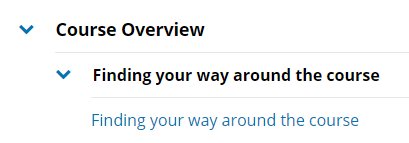
Where are the audio files?
Are you having trouble with the audio files in the Listening Module? Some listeners have had trouble downloading them. We've checked the audio files personally and they are all there. Here are some things you can try if you are having problems locating the audio files:
- The issue may be related to your device or your internet speed. The audio files are the last to load on the page. Try accessing the course in another location where the internet speed is faster/more reliable. You should be able to see this icon:
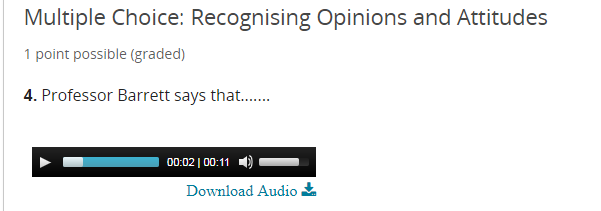
- If you are using the app and having problems downloading the audio, make sure that you have updated the app. If you are still having problems, this may be related to your phone model or operating system. If this is the case, try accessing the course via Google Chrome instead.
- This course is best viewed with the latest version of common browsers such as Google Chrome. The edX platform is routinely tested and verified on the current version and the previous version of each of these browsers. Make sure you are using the latest version.
- Also, please note that the first audio in Listening Unit 1 only appears half way through the unit, here: Listening - Unit 1: Unit Overview - Listening for the Main Idea. The exercises in the first half of this unit do not require audio.
How is my progress on the course monitored?
Any activity with a pencil symbol beside it will contribute to your progress mark. Make sure that you do all the questionnaire/Unit review check lists to ensure that the progress bar increases.
How can I get my microphone to work?
Make sure you are using the latest version of common browsers and be sure to give permission to IELTSx to use your microphone (follow the picture below). If your microphone worked in the past, you might need to clear your browsing history and try again.
Always allow on this site:

Allow IELTSx to use your microphone:
